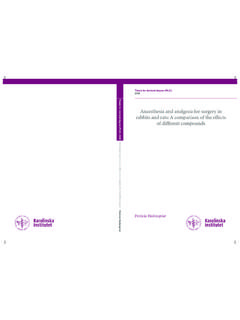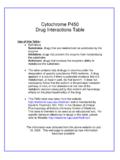Transcription of Sevoflurane, USP - Sevoflurane
1 Sevoflurane , USPV olatile Liquid for InhalationDESCRIPTION Sevoflurane , USP, volatile liquid for inhalation, a nonflammable and nonexplosive liquid administered by vaporization, is a halogenated general inhalation anesthetic drug. Sevoflurane , USP is fluoromethyl 2,2,2,-trifluoro-1-(trifluoromethyl) ethyl ether and its structural formula is: Sevoflurane , USP, Physical Constants are:Molecular weight point at 760 mm Hg CSpecific gravity at 20 C - pressure in mm Hg 157 mm Hg at 20 C197 mm Hg at 25 C317 mm Hg at 36 CDistribution Partition Coefficients at 37 C:Blood/Gas - Oil/Gas 47 - 54 Component/Gas Partition Coefficients at 25 C for Polymers Used Commonly in Medical Applications:Conductive rubber rubber , USP is nonflammable and nonexplosive as defined by the requirements of International Electrotechnical Commission , USP is a clear, colorless, liquid containing no additives.
2 Sevo- flurane, USP is not corrosive to stainless steel, brass, aluminum, nickel-plated brass, chrome-plated brass or copper beryllium. Sevoflurane , USP is non- pungent. It is miscible with ethanol, ether, chloroform, and benzene, and it is slightly soluble in water. Sevoflurane , USP is stable when stored under normal room lighting conditions according to instructions. No discernible degradation of Sevoflurane , USP occurs in the presence of strong acids or heat. When in contact with alkaline CO2 absorbents ( Baralyme and to a lesser extent soda lime) within the anesthesia machine, Sevoflurane , USP can undergo degradation under certain conditions. Degradation of Sevoflurane , USP is minimal, and degradants are either undetectable or present in non- toxic amounts when used as directed with fresh absorbents.
3 Sevoflurane , USP degradation and subsequent degradant formation are enhanced by increasing absorbent temperature increased Sevoflurane , USP concentration, decreased fresh gas flow and desiccated CO2 absorbents (especially with potassium hydroxide containing absorbents Baralyme). Sevoflurane , USP alkaline degradation occurs by two pathways. The first results from the loss of hydrogen fluoride with the formation of pentafluoroisopropenyl fluoromethyl ether, (PIFE, C4H2F6O), also known as Compound A, and trace amounts of penta- fluoromethoxy isopropyl fluoromethyl ether, (PMFE, C5H6F6O). The second pathway for degradation of Sevoflurane , USP, which occurs primarily in the presence of desiccated CO2 absorbents, is discussed the first pathway, the defluorination pathway, the production of degradants in the anesthesia circuit results from the extraction of the acidic proton in the presence of a strong base (KOH and/or NaOH) forming an alkene (Compound A) from Sevoflurane , USP similar to formation of 2-bromo-2-chloro-1,1-difluoro ethylene (BCDFE) from halothane.
4 Laboratory simulations have shown that the concentration of these degradants is inversely correlated with the fresh gas flow rate (See Figure 1).Since the reaction of carbon dioxide with absorbents is exothermic, the temperature increase will be determined by quantities of CO2 absorbed, which in turn will depend on fresh gas flow in the anesthesia circle system, metabolic status of the patient, and ventilation. The relationship of temperature produced by varying levels of CO2 and Compound A production is illustrated in the following in vitro simulation where CO2 was added to a circle absorber A concentration in a circle absorber system increases as a function of increasing CO2 absorbent temperature and composition (Baralyme producing higher levels than soda lime), increased body temperature, and increased minute ventilation, and decreasing fresh gas flow rates.
5 It has been reported that the concentration of Compound A increases significantly with prolonged dehydration of Baralyme. Compound A exposure in patients also has been shown to rise with increased Sevoflurane , USP concentrations and duration of anesthesia. In a clinical study in which Sevoflurane , USP was administered to patients under low flow conditions for 2 hours at flow rates of 1 Liter/minute, Compound A levels were measured in an effort to determine the relationship between MAC hours and Compound A levels produced. The relationship between Compound A levels and Sevoflurane , USP exposure are shown in Figure A has been shown to be nephrotoxic in rats after exposures that have varied in duration from one to three hours.
6 No histopathologic change was seen at a concentration of up to 270 ppm for one hour. Sporadic single cell necrosis of proximal tubule cells has been reported at a concentration of 114 ppm after a 3-hour exposure to Compound A in rats. The LC50 reported at 1 hour is 1050-1090 ppm (male-female) and, at 3 hours, 350-490 ppm (male-female).An experiment was performed comparing Sevoflurane , USP plus 75 or 100 ppm Com- pound A with an active control to evaluate the potential nephrotoxicity of Compound A in non-human primates. A single 8-hour exposure of Sevoflurane , USP in the presence of Compound A produced single-cell renal tubular degeneration and single-cell necrosis in cynomolgus monkeys. These changes are consistent with the increased urinary protein, glucose level and enzymic activity noted on days one and three on the clinical pathology evaluation.
7 This nephrotoxicity produced by Compound A is dose and duration of exposure a fresh gas flow rate of 1 L/min, mean maximum concentrations of Compound A in the anesthesia circuit in clinical settings are approximately 20 ppm ( ) with soda lime and 30 ppm ( ) with Baralyme in adult patients; mean maximum concentrations in pediatric patients with soda lime are about half those found in adults. The highest concentration observed in a single patient with Baralyme was 61 ppm ( ) and 32 ppm ( ) with soda lime. The levels of Compound A at which toxicity occurs in humans is not second pathway for degradation of Sevoflurane , USP occurs primarily in the presence of desiccated CO2 absorbents and leads to the dissociation of Sevoflurane , USP into hexafluoroisopropanol (HFIP) and formaldehyde.
8 HFIP is inactive, non-genotoxic, rapidly glucuronidated and cleared by the liver. Formaldehyde is present during normal metabolic processes. Upon exposure to a highly desiccated absorbent, formaldehyde can further degrade into methanol and formate. Formate can contribute to the formation of carbon monoxide in the presence of high temperature that can be associated with desiccated Baralyme . Methanol can react with Compound A to form the methoxy addition product pentafluromethoxy isopropyl fluoromethyl ether (PMFE). This compound can undergo further HF elimination to form additional , USP degradants were observed in the respiratory circuit of an experimental anesthesia machine using desiccated CO2 absorbents and maximum Sevoflurane , USP concentrations (8%) for extended periods of time ( 2 hours).
9 Concentrations of for- maldehyde observed with desiccated soda lime in this experimental anesthesia respiratory circuit were consistent with levels that could potentially result in respiratory irritation. Although KOH containing CO2 absorbents are no longer commercially available, in the laboratory experiments, exposure of Sevoflurane , USP to the desiccated KOH containing CO2 absorbent, Baralyme, resulted in the detection of substantially greater degradant PHARMACOLOGY Sevoflurane , USP is an inhalational anesthetic agent for use in induction and maintenance of general anesthesia. Minimum alveolar concentration (MAC) of Sevoflurane , USP in oxygen for a 40-year-old adult is The MAC of Sevoflurane , USP decreases with age (see DOSAGE AND ADMINISTRATION for details).
10 Pharmacokinetics UPTAKE AND DISTRIBUTIONS olubilityBecause of the low solubility of Sevoflurane , USP in blood (blood/gas partition coefficient @ 37 C = ), a minimal amount of Sevoflurane , USP is required to be dissolved in the blood before the alveolar partial pressure is in equilibrium with the arterial partial pressure. Therefore there is a rapid rate of increase in the alveolar (end-tidal) concentration (FA) toward the inspired concentration (FI) during of Anesthesia In a study in which seven healthy male volunteers were administered 70% N2O/30% O2 for 30 minutes followed by Sevoflurane , USP and isoflurane for another 30 minutes the FA /FI ratio was greater for Sevoflurane , USP than isoflurane at all time points.








